If there’s one bread that instantly reminds me of festive gatherings and the comforting aroma of saffron, it’s Sheermal. It’s a delicately sweet flatbread, dunked in saffron syrup, and the crispy crust is topped with loads of nuts. Soft, sweet, and buttery in every bite! This Persian-inspired bread is traditionally made in tandoors, but today, I’m sharing how you can make it perfectly at home using an oven.
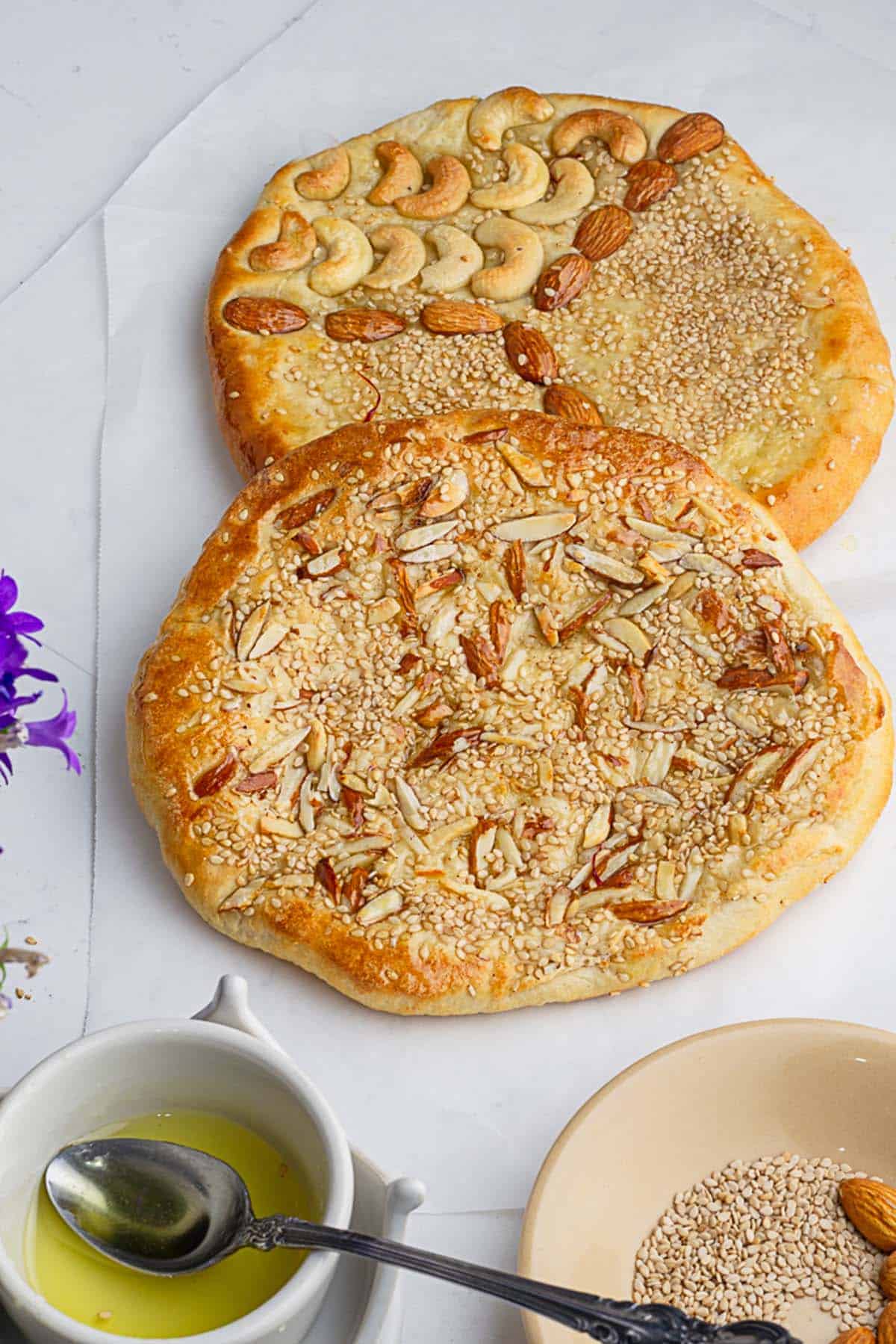
Flatbreads are some of the easiest and most satisfying breads to make and share. I usually stick to neutral or savory ones like kulcha, bullet naan, cheese naan, ragi roti, malalbar parotha, pita bread, and Turkish bread, etc. But sheer mall is one of the few flatbreads I make that leans toward the sweeter side. This rich, slightly sweet, and saffron-infused sweet naan hails from Awadhi cuisine and brings a delightful change of pace from the usual savory fare.
Jump to:
👩🏽🍳 Why You Should Try This Sheermal Recipe
- No tandoor needed – This recipe is designed for a regular home oven, yet it delivers that same soft, buttery texture and golden crust you'd expect from a traditional Sheermal.
- Infused with real saffron – The delicate aroma and color from the saffron syrup make every bite luxurious and unforgettable.
- Perfect balance of sweet and savory – With a slightly sweet crumb, crispy nutty crust, and rich ghee flavor, Sheermal pairs beautifully with both curries and tea.
- Beginner-friendly and fuss-free – Whether you're kneading by hand or using a stand mixer, the steps are simple and approachable, even if you're new to baking.
- Authentic yet adaptable – This is a classic Persian-inspired Indian flatbread recipe that stays true to its roots while being totally doable in your own kitchen.
🧂Ingredient Notes for Sheermal/ Shirmal Recipe
Before you dive into baking this aromatic Sheermal bread, here are some helpful notes on the ingredients—along with tips on substitutions and sourcing—so you can confidently make it with what you have at home.
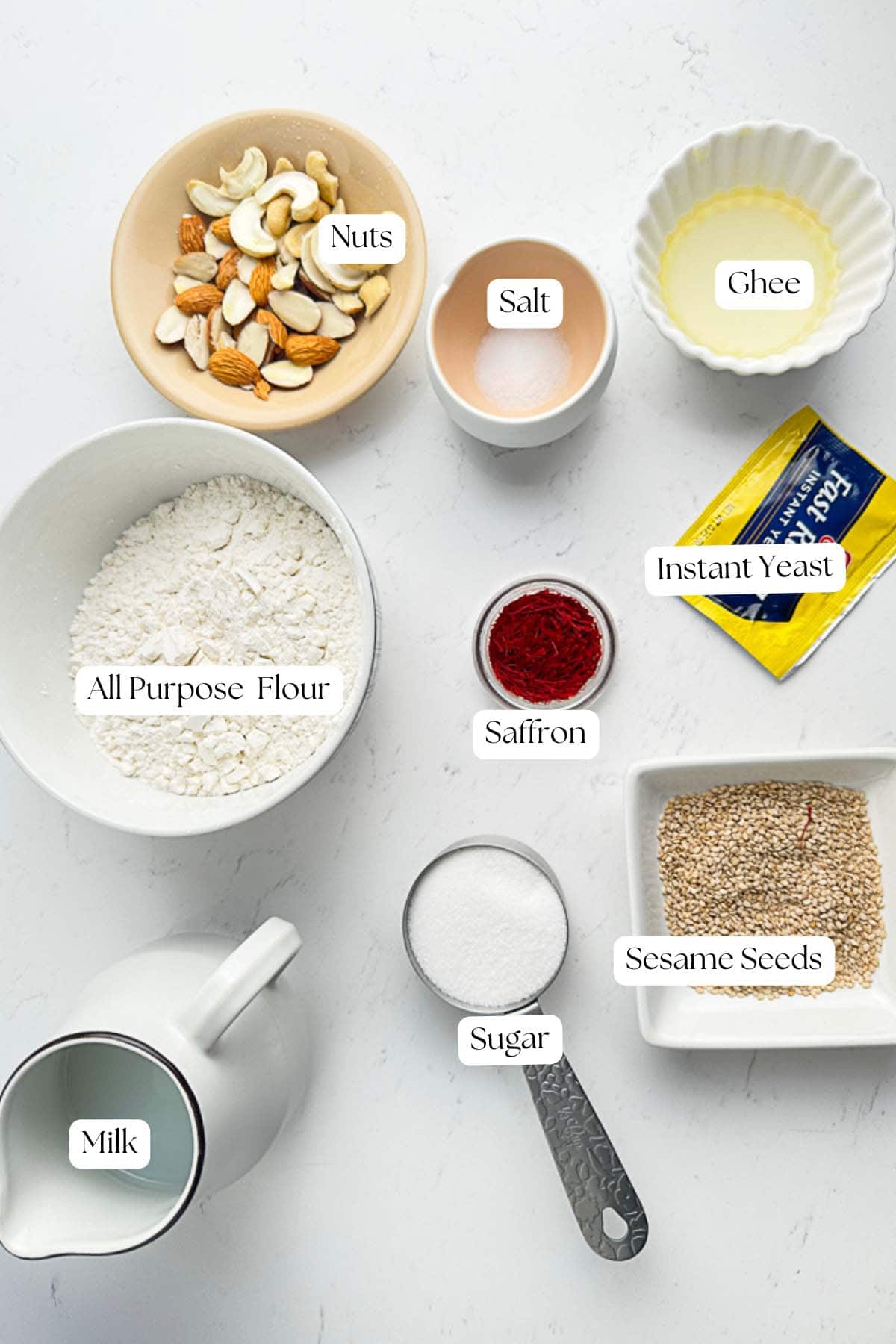
For Sheermal bread
- All-purpose flour (maida): This forms the base of the dough and gives Sheermal its soft, fluffy texture. You can substitute it with bread flour for a slightly chewier bite or a 50:50 mix of all-purpose and whole wheat flour for a nuttier flavor, though the texture will be denser.
- Whole milk: Full-fat milk adds richness and softness to the dough. You can use plant-based milk like almond or oat milk if you’re looking for a dairy-free version, but note that the flavor and texture may vary slightly. For an even richer Sheermal, try adding a tablespoon of milk powder.
- Ghee: This gives Sheermal its buttery aroma and soft crumb. If you don’t have ghee, unsalted butter works well. For a vegan alternative, use neutral-flavored oil or plant-based butter, though the traditional richness may be slightly reduced.
- Instant yeast: Instant yeast dissolves easily and speeds up the rise. If using active dry yeast, increase the quantity slightly and activate it in warm milk with a pinch of sugar before adding to the flour. Make sure your yeast is fresh for a good rise—check the expiration date!
- Salt: Just a little balances the sweetness and enhances overall flavor. Regular table salt works, but sea salt or Himalayan pink salt can be used for a cleaner taste.
- Sugar: Adds a touch of sweetness to the dough. You can use coconut sugar or jaggery powder if you prefer unrefined alternatives, but they will slightly darken the color and alter the flavor.
For the saffron syrup:
- Sugar: Use white granulated sugar to make the syrup smooth and light in color. Avoid brown sugar here, as it may overpower the delicate saffron notes.
- Saffron strands: The soul of Sheermal naan / Shirmal lies in these golden threads. Look for pure Kashmiri saffron or Persian saffron—you’ll find them in Indian grocery stores, specialty spice shops, or online. Always soak saffron in warm water or milk to release its aroma and color. If saffron is hard to find, a pinch of turmeric can mimic the yellow hue, but it won’t replicate the signature flavor. Half a teaspoon of rose water can also be used to enhance the flavor.
🔪 Instructions to make Sheermal Bread
Step 1: Kneading the Dough

To start making your Sheermal bread, combine all your dry ingredients—flour, sugar, salt, and instant yeast—in a large mixing bowl. Warm the milk slightly (it should feel lukewarm to the touch, not hot) and gradually add it to the flour mixture along with melted ghee.
If kneading by hand: Mix everything with a wooden spoon or your hands until a shaggy dough forms. Transfer it onto a lightly floured surface and knead for about 8–10 minutes, until the dough becomes smooth, soft, and elastic. Don’t worry if it feels slightly sticky initially—it will come together as you knead.
If using a stand mixer: Attach the dough hook and mix on low speed for about 6-7 minutes until the dough starts to pull away from the sides. Increase speed to medium and knead for another 4–5 minutes until soft and supple.
You’re looking for a smooth, pliable dough that springs back slightly when pressed. Lightly oil a bowl and place the dough inside, turning it once to coat. Cover with a clean kitchen towel or plastic wrap.
Step 2: Bulk Fermentation
Place the covered bowl in a warm, draft-free spot and let the dough rise until doubled in size, which should take around 60–90 minutes, depending on your room temperature. The dough should look puffed up and feel airy when pressed gently with your fingers.
Step 3: Shaping
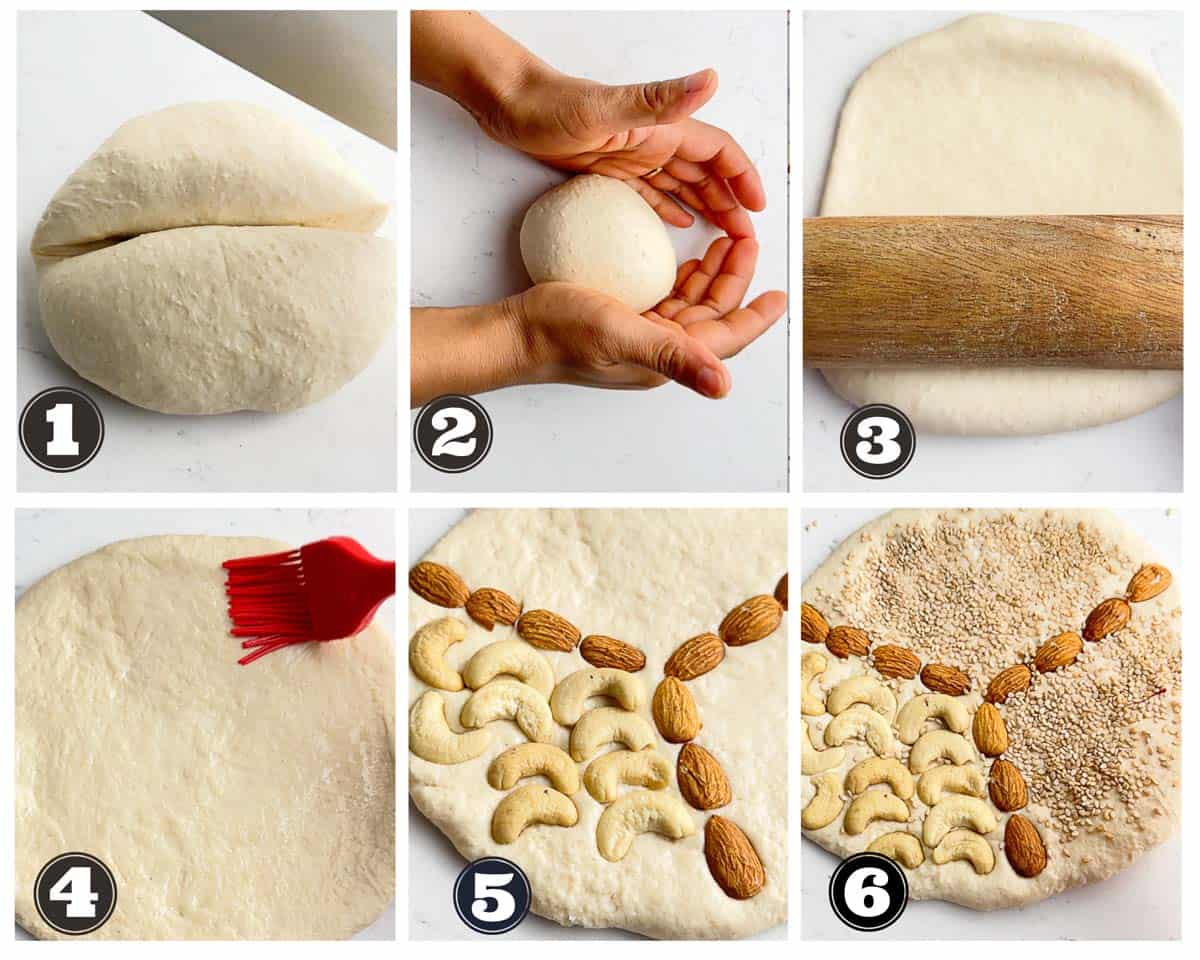
Once the dough has doubled, gently deflate it. Turn it onto a clean surface and divide into two equal parts. The next step is to form them into smooth balls. Grab one dough ball and dust it with flour.
Dust the work surface with flour and roll it out into a thick circle, about ½ inch thick. While doing so keep lifting it up and sprinkle more flour under it. Try to keep it even all around—this helps the Sheermal bake evenly and gives it that beautiful round shape.
Use a fork to prick the surface all over—this is a traditional step that prevents it from puffing up too much in the oven.
Next, lightly brush or spray the surface with water to help the toppings stick. Now, sprinkle your choice of nuts over the top—almonds, pistachios, or walnuts all work beautifully. If you'd like, you can create a decorative pattern with the nuts or keep it simple by scattering some sesame seeds for a classic finish. It's entirely up to your taste and creativity! Repeat the process with the another dough ball.
Step 4: Baking
Preheat your oven to 470°C (243°F) with a baking stone or heavy sheet pan or baking tray inside to mimic the high heat of a tandoor. Once the oven is fully heated, transfer the shaped dough onto a piece of parchment paper and slide it onto the hot stone.
Bake for 5-6 minutes, or until the top is golden brown and the bottom sounds hollow when tapped. Keep a close eye toward the end—every oven is slightly different.
Step 5: Making the Saffron Syrup

While the Sheermal is baking, make your saffron syrup. Heat a small saucepan and add sugar with three tablespoons of water. Stir over low heat until the sugar dissolves completely. Now add the saffron strands and let the syrup simmer for a minute. Turn off the heat and let it steep so the saffron infuses deeply, giving you that vibrant color and aroma.
Step 6: Assembling the Sheermal
As soon as the Sheermal comes out of the oven, brush it generously with ghee while it’s still hot. Then, while the bread is warm and ready to soak up flavor, pour or brush the saffron syrup over the top, letting it seep into the crumbs. This creates those signature saffron syrup-dunked crumbs topped with a nut-filled and crispy crust.
Let it rest for a few minutes before slicing. Serve warm, and enjoy this regal treat with Chai, curry, or just on its own!
📝 Recipe Notes
When making authentic Sheermal bread at home, a few small tweaks and tips can make a big difference in the outcome.
- Always warm the milk slightly—if it’s too cold, the yeast won’t activate, and if it’s too hot, it might kill the yeast.
- The dough should be soft and just a little sticky; resist the urge to add more flour, as that can make the bread dense.
- If you don't have saffron, you can use a few drops of kesar essence or turmeric just for color, but saffron is key for that rich aroma.
- For those avoiding dairy, plant-based milk and vegan butter work, though the flavor will be milder.
- To get that golden, slightly crispy top, don’t skip the fork-pricking step before baking, and make sure to brush ghee and syrup while the Sheermal is still hot—this helps the syrup soak into the crumb.
- If the bread seems too soft or pale, try baking it a couple of minutes longer, but not more than 10-12 minutes total.
- Use a preheated baking stone or heavy sheet pan to mimic the tandoor’s high heat—this gives a better rise and crisp base. Always give the dough enough time to rise; rushing bulk fermentation can lead to flat, chewy bread instead of the soft, tender Sheermal you're aiming for.
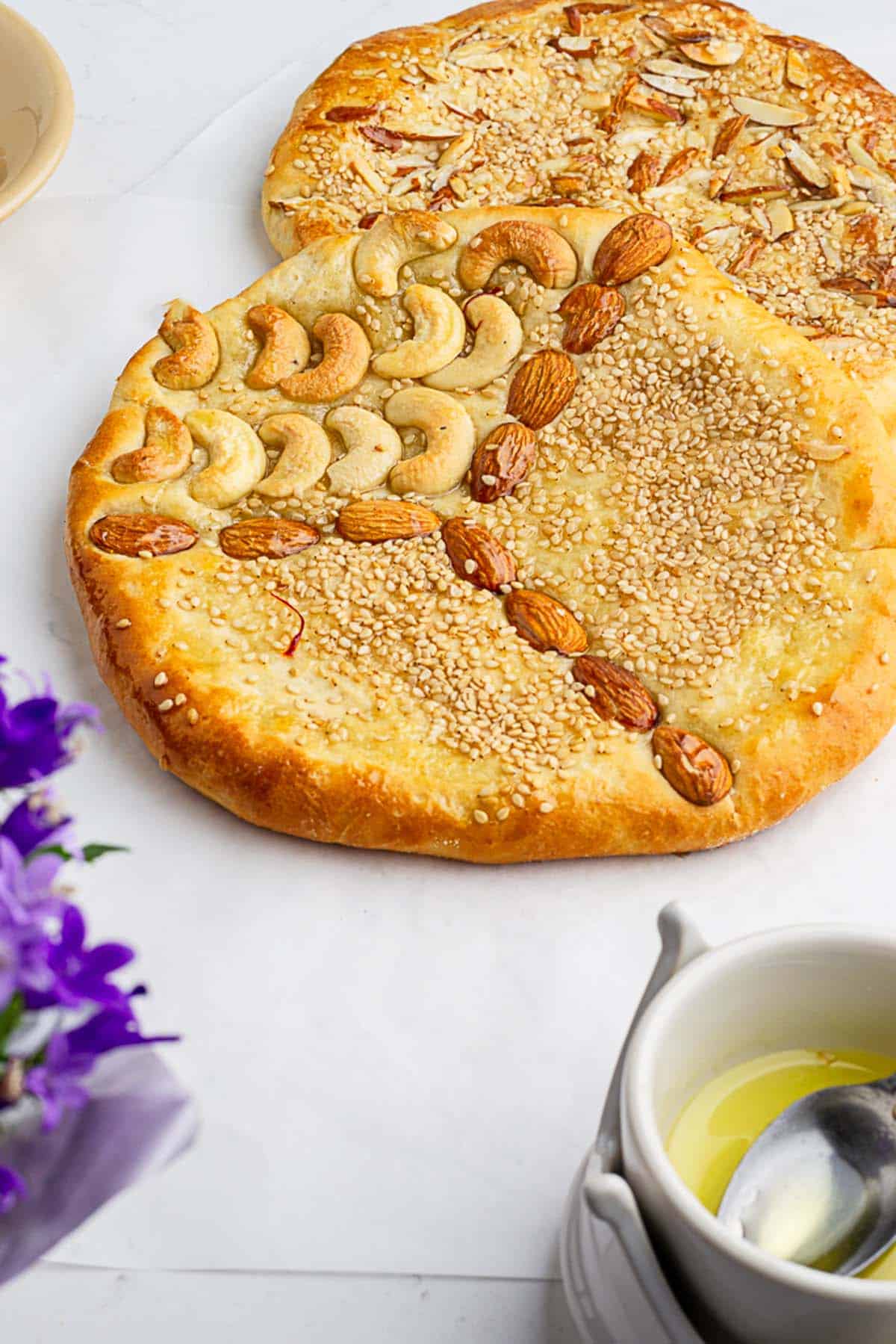
🫙Storage Notes
Sheermal is best enjoyed fresh out of the oven when it's still warm, soft, and fragrant—but don’t worry if you have leftovers! Here’s how to store and reheat Sheermal so you can enjoy it later without losing its signature softness and flavor.
Storing Sheermal:
- At room temperature: Once completely cooled, wrap the Sheermal tightly in foil or keep it in an airtight container. It will stay fresh for up to 2 days at room temperature. Avoid storing it uncovered, as it can dry out quickly.
- In the fridge: If you want to keep it a little longer, store it in the refrigerator wrapped in foil or a zip-lock bag. It should last for 4–5 days this way. However, note that refrigeration may slightly dry it out, so reheating properly is key.
- Freezing: Sheermal freezes beautifully! Wrap individual pieces in cling film and then place them in a freezer-safe bag or container. They can be frozen for up to 2 months. Just remember to thaw them at room temperature before reheating.
🔥 Reheating Instructions
- In the oven: Preheat your oven to 160°C (320°F). Lightly sprinkle the Sheermal with a few drops of water (to prevent drying), wrap it in foil, and warm for 5–7 minutes until soft and heated through.
- On a skillet: Place the Sheermal on a hot tawa or non-stick pan over low heat. Cover with a lid and warm for 2–3 minutes on each side, flipping once. You can brush it with a little ghee before or after heating to refresh the flavor.
- In the microwave: Wrap the Sheermal in a damp paper towel and microwave for 15–20 seconds. This method is quick but best used for small portions, as it can turn chewy if overheated.
Once reheated, you can drizzle a bit more saffron syrup or ghee on top to revive its luscious, melt-in-the-mouth texture.
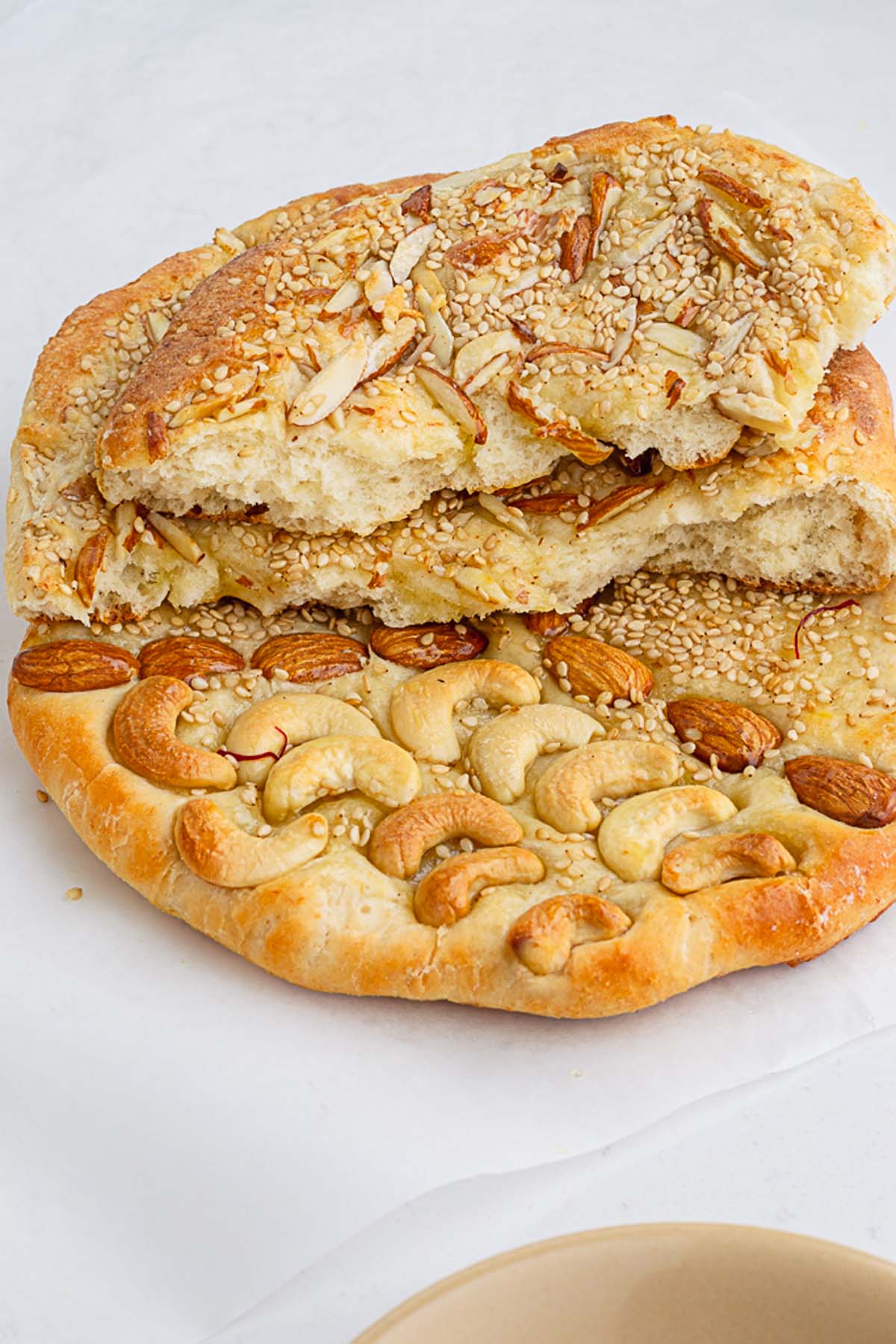
❓Frequently Asked Questions (FAQ)
While naan and kulcha are savory flatbreads often served with rich gravies, Sheermal is a mildly sweet, saffron-flavored flatbread traditionally enriched with milk, ghee, and sugar. Unlike naan, which is usually leavened with yogurt or baking soda, Sheermal is made with yeast, giving it a soft, fluffy texture.
Another major difference is that Sheermal is brushed with saffron-infused sugar syrup after baking, which gives it a subtle sweetness and golden hue. It’s often enjoyed on its own or served with mildly spiced kebabs or curries. If you're looking for an authentic Indian saffron flatbread recipe, Sheermal is a delicious and unique choice.
Yes, although saffron and ghee are key ingredients in traditional Sheermal bread, there are alternatives if you’re missing either. If saffron is unavailable, you can use a pinch of turmeric or saffron essence for color, though you’ll lose the signature aroma. Ghee can be replaced with unsalted butter or neutral vegetable oil, but using butter will come closest to replicating the rich flavor.
Keep in mind that without saffron flavored syrup and ghee, the final result will taste a bit different, but it will still be a soft and slightly sweet flatbread. For a vegan Sheermal recipe, use plant-based milk and butter substitutes.
If your Sheermal turns out dry or dense, it's usually due to either overbaking, using too much flour, or not kneading the dough enough. This flatbread needs a soft, slightly tacky dough that’s kneaded well to develop gluten, which gives it that characteristic pillow-like texture.
Overbaking can also dry it out—keep an eye on it in the last few minutes, and remove as soon as the top is golden. Also, make sure the yeast is active and fresh. If your dough doesn’t rise properly during bulk fermentation, the bread will lack airiness. For best results, follow the rise times closely and avoid adding excess flour while kneading.
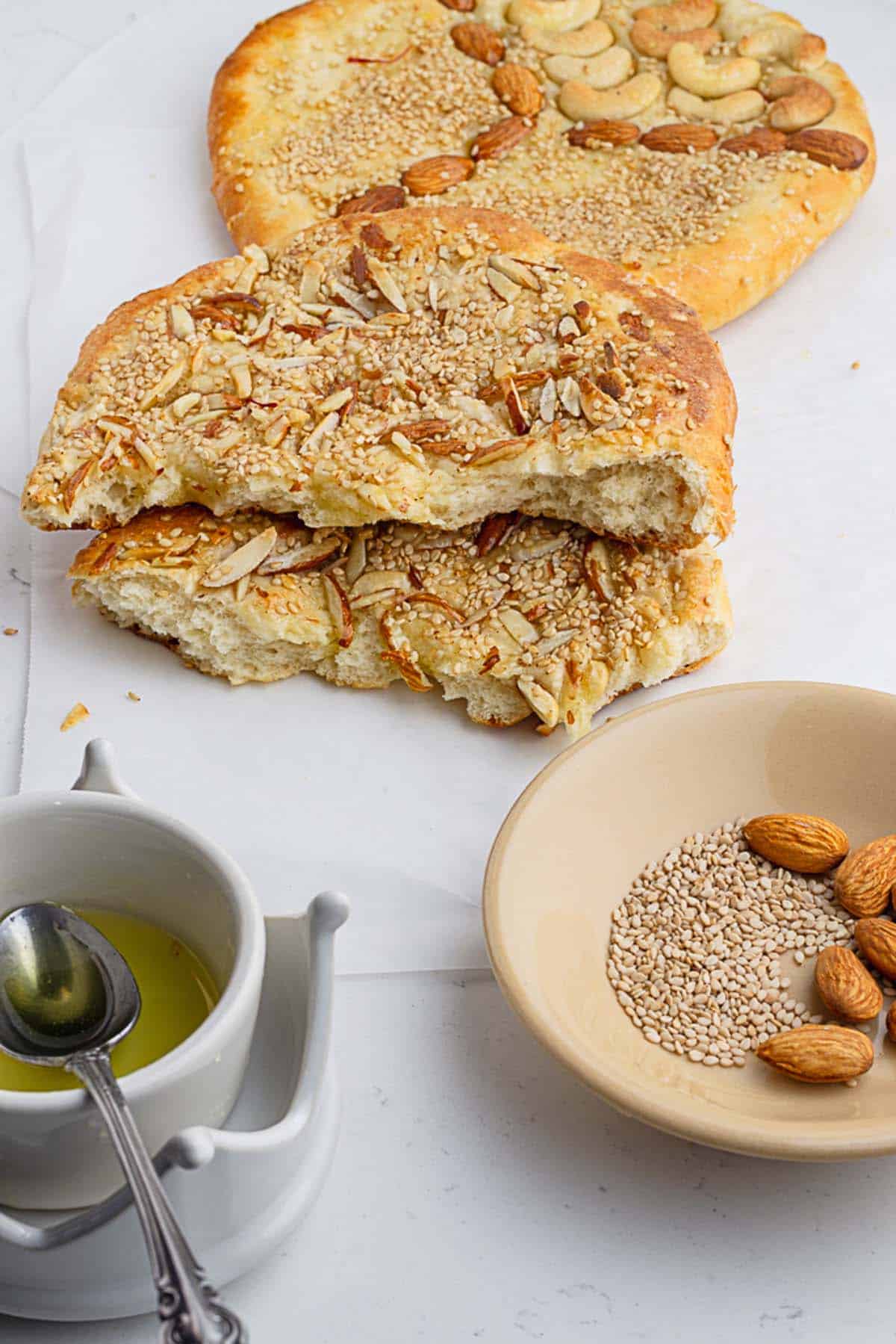
🔗 More bread recipes
I hope you give this homemade Sheermal recipe a try—it's soft, saffron-kissed, and full of warmth. If you bake it, don’t forget to tag me or leave a comment below—I’d love to see your golden creations!
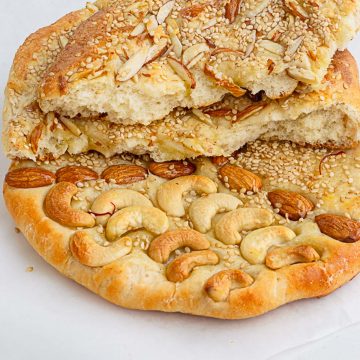
Sheermal
Ingredients
Ingredients for dough
- 200 g All purpose flour (1 ⅔ cups )
- 124 g Whole milk (½ cup)
- 2 teaspoon ghee
- 2 teaspoon instant yeast
- ½ teaspoon salt
- 1 teaspoon sugar
Ingredients For syrup
- ¼ cup sugar
- 7-8 strands of saffron
Instructions
Step 1: Kneading the Dough
- Combine flour, sugar, salt, and instant yeast in a large mixing bowl.
- Warm the milk until it feels lukewarm (not hot) and gradually add it to the flour mixture along with melted ghee.
- If kneading by hand, mix everything with a wooden spoon or your hands until a shaggy dough forms.
- Transfer the dough onto a lightly floured surface and knead for about 8–10 minutes until smooth, soft, and elastic.
- If using a stand mixer, attach the dough hook and mix on low speed for 6–7 minutes until the dough starts to pull away from the sides.
- Increase to medium speed and knead for another 4–5 minutes until the dough is soft and supple.
- Look for a smooth, pliable dough that springs back slightly when pressed.
- Lightly oil a bowl, place the dough inside, and turn it once to coat.
- Cover the bowl with a clean kitchen towel or plastic wrap.
Step 2: Bulk Fermentation
- Place the covered bowl in a warm, draft-free spot.
- Let the dough rise until doubled in size, about 60–90 minutes depending on room temperature.
- The dough should look puffed up and feel airy when gently pressed.
Step 3: Shaping
- Gently deflate the dough once it has doubled.
- Turn the dough onto a clean surface and divide it into two equal parts.
- Form each portion into a smooth ball.
- Dust one dough ball with flour and roll it out into a thick circle, about ½ inch thick.
- Lift and sprinkle more flour under it as needed to prevent sticking.
- Ensure the circle is rolled out evenly for uniform baking.
- Prick the surface all over with a fork to prevent excessive puffing in the oven.
- Lightly brush or spray the surface with water to help the toppings stick.
- Sprinkle with your choice of toppings such as almonds, pistachios, walnuts, or sesame seeds.
- Optionally, create decorative patterns with the nuts or keep it simple.
- Repeat the same process with the second dough ball.
Step 4: Baking
- Preheat your oven to 470°F (243°C) with a baking stone or heavy sheet pan inside.
- Once the oven is fully heated, place the shaped dough on parchment paper and slide it onto the hot stone.
- Bake for 5–6 minutes or until the top is golden brown and the bottom sounds hollow when tapped.
- Keep a close eye near the end of baking, as oven performance may vary.
Step 5: Making the Saffron Syrup
- While the bread is baking, heat a small saucepan and add sugar with three tablespoons of water.
- Stir over low heat until the sugar dissolves completely.
- Add saffron strands and let the syrup simmer for a minute.
- Turn off the heat and allow the syrup to steep, letting the saffron infuse for a vibrant color and aroma.
Step 6: Assembling the Sheermal
- As soon as the Sheermal comes out of the oven, brush it generously with ghee while it’s still hot.
- Pour or brush the saffron syrup over the warm bread so it can soak into the crumb.
- This step creates saffron-infused crumbs with a nut-filled and crispy crust.
- Let the bread rest for a few minutes before slicing.
- Serve warm with chai, curry, or enjoy on its own.
Notes
- Let your dough rest undisturbed during bulk fermentation—cutting that time short is one of the quickest ways to end up with a flat, chewy Sheermal instead of the soft, pillowy texture you're after.
- A baking stone or a heavy-duty sheet pan that’s been preheated in the oven can work wonders. It mimics the intense heat of a tandoor, giving your Sheermal a crisp bottom and encouraging a nice rise.
- Warm milk is crucial for yeast to do its job. It should feel comfortably warm to the touch—not cold, not hot. Too cold, and the yeast stays dormant; too hot, and you’ll end up killing it.
- When kneading, aim for a dough that feels soft and slightly tacky. Avoid the temptation to add more flour—it might seem sticky at first, but over-flouring can turn your Sheermal dense and heavy.
- Pricking the rolled-out dough with a fork before baking might seem like a small detail, but it makes a big difference. It helps the Sheermal bake evenly and keeps the surface beautifully flat instead of puffing up.
- Don’t delay when the Sheermal comes out of the oven—brush it right away with ghee and drizzle or brush on the saffron syrup while it’s still hot. This lets the syrup seep into the crumb, creating that signature soft and aromatic interior.
- No saffron on hand? Kesar essence or even a pinch of turmeric can be used to mimic the golden hue, but keep in mind they won’t provide the same luxurious fragrance that saffron brings.
- If you're baking dairy-free, you can easily swap in plant-based milk and vegan butter. The texture stays similar, though the flavor will be slightly more neutral.
- If your bread looks pale or feels too soft, leave it in the oven for just a couple more minutes—but keep an eye on it. Total bake time shouldn’t exceed 10–12 minutes to avoid drying it out.


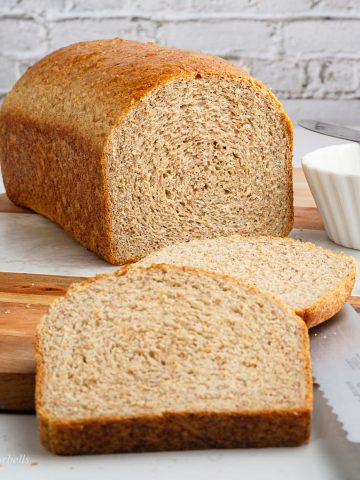
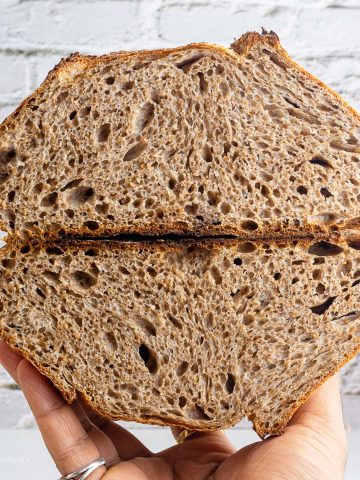


Leave a Reply